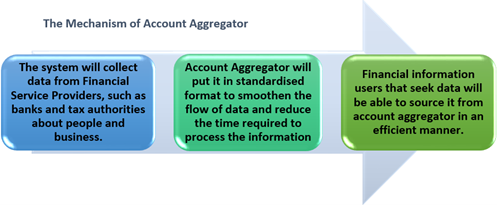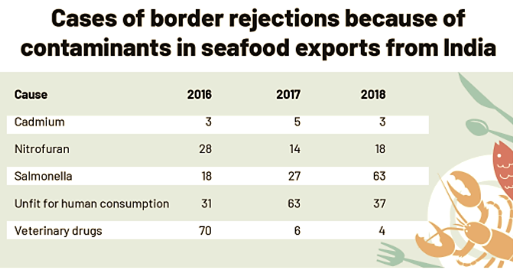Wednesday, 8th September 2021
Implementation of National Education Policy (NEP)
In News
The Prime Minister has launched key initiatives in the education sector while addressing ‘Shikshak Parv 2021’ conclave.
Key Initiatives
- Indian Sign Language dictionary: This will include audio and text embedded sign language video for the hearing impaired, in conformity with universal design of learning. The dictionary, of 10,000 words, has been launched by Indian Sign Language Research and Training centre of DPwD.
- Talking Books (audio books for visually impaired): It will have recorded magazines; textbooks for college students; and books of general interest in different languages on Reel-to-Reel Magnetic Tape Recorders which the visually impaired users listen to on huge Multi-Track Players.
- School Quality Assessment and Accreditation Framework (SQAAF) of CBSE: It aspires to provide quality education to students through standardized instruments and processes of self-evaluation and external assessment benchmarks.
- NISTHA teachers' training programme for NIPUN Bharat: It is a platform that provides training to teachers on how to make education more enjoyable for a practical understanding.
- Vidyanjali Portal: It will facilitate education volunteers, donors and CSR contributors for school development. The Vidyanjali site will allow community members and volunteers to participate by connecting directly with government and government-aided schools.
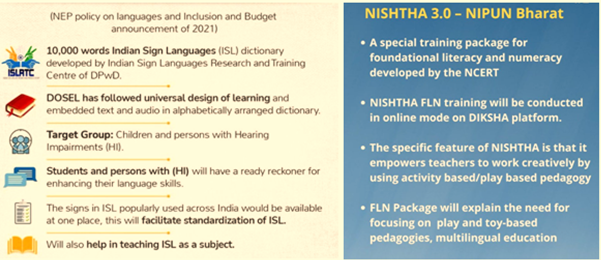
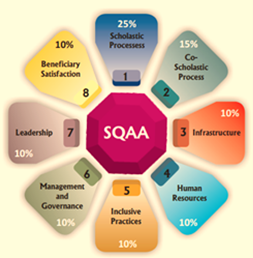
Source:
- Shikshak Parv | Help improve quality in government schools, PM Modi urges private sector
- Private sector must help improve education quality in govt schools: PM Modi
- Shikshak Parv 2021 Live: PM Modi launches key initiatives in education sector
- http://www.nabindia.org/talking-books/
- School Quality Assessment and Assurance
- NISHTHA 3.0 Under NIPUN Bharat is a Platform That Provides Training to Teachers on How to ... - Latest Tweet by PIB India
- Vidyanjali Portal launched: PM Modi
Image source:
Pollen calendar
In News
Post Graduate Institute of Medical Education and Research (PGIMER) and Punjab University have created a pollen calendar for Chandigarh, the first for any city in India.
About the News
- Pollen calendars represent the time dynamics of airborne pollen present in a particular geographical area.
- Such calendars are location-specific, as pollen concentrations are closely related to locally distributed flora.
- Europe, UK and the US are using regional pollen calendars in a big way to prevent and diagnose allergic rhinitis/hay fever and predict the timing and severity of the pollen season.
- People can access the Pollen Calendar through the Care 4 Clean Air
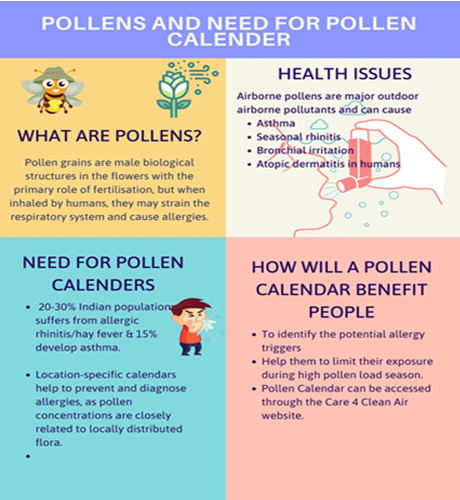
Significance of a Pollen calendar
- Effect of Pollens on Humans: When pollens are inhaled by humans, they may strain the respiratory system and cause allergies.
- Pollen found suspended in air can cause widespread upper respiratory tract and naso-bronchial allergy with manifestations like asthma, seasonal rhinitis, and bronchial irritation.
- Pollen is considered a major outdoor airborne allergen responsible for allergic rhinitis, asthma, and atopic dermatitis in humans.
- Clear Identification: A pollen calendar provides a clear understanding for clinicians and people with allergies to identify the potential allergy triggers and help to limit their exposure to pollens.
- Forecasting: The early advisories can be prepared and disseminated through media channels to the citizens so that they can use protective gear during the period when the concentration of allergic pollen will be high.
Source:
T+1 settlement
In News
The Securities and Exchange Board of India (SEBI) has introduced T+1 (Trade plus 1 day) rolling settlement cycle for stocks on an optional basis.
About the News
- Present Structure: Currently, trades on the Indian stock exchanges are settled within two days (T+2), just like most major markets such as Singapore, Hong Kong, Australia, Japan, and South Korea.
- New Structure: With the new rule, which will come into force on January 1, 2022, Stock Exchanges will have flexibility to offer either T+1 or T+2 settlement cycle.
- Exchanges will have to give advance notice of at least one month regarding the change in the settlement cycle.
- Benefits: Reduced time between transaction and settlement
- It increases market liquidity and trading turnover
- Reduces settlement risk and broker defaults.
- Reduced risks will also lead to reduced margin requirements while buying a stock.
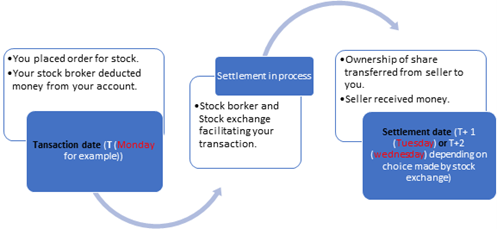
Concerns regarding the new mechanism
- Time Zone Problems: Foreign Portfolio Investors/Foreign Institutional Investors (FPIs/FIIs), who have been one of the biggest drivers of India’s financial markets, are expected to face considerable operational challenges in adjusting to the new regime because of the difference in time zones, especially for the US and European
- Operational challenges: Two different settlement cycles on different exchanges for the same scrip could also result in operational challenges.
- Structural challenges: A market transition to T+1 would require significant, coordinated, and expensive structural changes to the settlement process, including technological enhancements and real-time/near real-time trade processing
Source:
Ghol Fish
This is the image of Ghol fish, a rarely found fish. Recently, a fisherman from Maharashtra caught around 150 Ghol fishes in his net in one go. Ghol fish, scientifically known as Protonibea diacanthus, is among the most expensive marine fish. It is in great demand in south-east Asia and Hong Kong. Its fins are said to have medicinal value and are also used in wine production in Singapore. The fish is also known as "the fish with the heart of gold.

Source:
Account Aggregator
In News
The Reserve Bank of India’s account aggregator framework went live recently.
About the News
- Account Aggregator (AA): According to the RBI, an AA is a non-banking financial company engaged in the business of providing, under a contract, the service of retrieving or collecting financial information pertaining to its customer. The data collection, collation and sharing are enabled through open application programming interface (API) connections.
- Banks in the Network: Eight of India’s major banks — State Bank of India, ICICI Bank, Axis Bank, IDFC First Bank, Kotak Mahindra Bank, HDFC Bank, IndusInd Bank and Federal Bank — joined the Account Aggregator (AA).
- India Stack: This initiative is part of India Stack, a collection of APIs that anyone can use to build new applications, making use of the common standards and protocols laid out in the APIs. UPI and eKYC also have the origins from India Stack.
- Regulatory Framework: The AA framework was created through an inter-regulatory decision by RBI and other regulators including SEBI, IRDA, and PFRDA through and initiative of the Financial Stability and Development Council (FSDC).
-
- The licence for AAs is issued by the RBI, and the financial sector will have many AAs.
Working of an Account Aggregator System
- Process: Account Aggregator, FIP (Financial Information Provider) and FIU (Financial Information User). An FIP is the data fiduciary, which holds customers’ data. It can be a bank, NBFC, mutual fund, insurance repository or pension fund repository.
- An FIU consumes the data from an FIP to provide various services to the consumer. An FIU is a lending bank that wants access to the borrower’s data to determine if the borrower qualifies for a loan. Banks play a dual role – as an FIP and as an FIU.
- Customer Authentication: An AA should share information only with the customer to whom it relates or any other financial information user as authorised by the customer. User authentication credentials of customers relating to accounts with various FIPs shall not be accessed by the AA
- Encryption: Data transmitted through the AA is encrypted. AAs are not allowed to store, process and sell the customer’s data. No financial information accessed by the AA from an FIP should reside with the AA
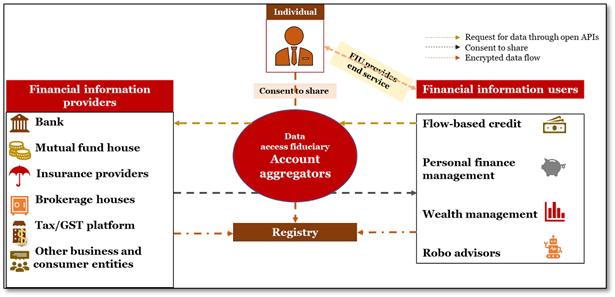
Why We Need Account Aggregators?
- Increased Digital Footprint: With the advent of digital payment systems, the amount of data being generated every minute is enormous. This financial data needs to be secured, channelized and utilised for effective financial management.
- Fragmented Financial System: An individual’s or entity’s data is usually fragmented and spread across silos in data warehouses of financial institutions, government bodies and various other business entities. There are no frameworks for seamless, safe and swift data sharing.
- Lack of Dynamism: Due to lack of solutions and services to aggregate and integrate user data for a seamless, wide-ranging view of data in real time, the fragmented information is not effectively optimised to provide comprehensive service delivery to users.
Benefits of Data Aggregation
- Wealth Management: The Account Aggregator framework is expected to revolutionise lending, wealth management and financial planning in the next few years, as individuals start to control the flow of their data held currently in silos across various financial institutions.
- Ease for Customers: The account aggregator system hopes to ease data sharing between these various financial services players. It eliminates the need to collect paper statements and manually key data into financial planning, performance reporting, CRM, client portals, etc.
- Enhanced options for Customers: Consumers using the AA financial utility will benefit from greater choice of products, better pricing, and increased financial inclusion.
- AAs as consent custodians: The core principle of AA platforms built on Data Empowerment and Protection Architecture (DEPA) is to give users complete authority over how their data will be used. A user registering with an AAs will be able to provide or retract consent for sharing data in any of her/his accounts with an FIP.
- Empowering Tool: AAs can become agents of financial inclusion by shifting from asset-backed lending to cash-flow based lending. This can enable them to serve individuals and MSMEs, which were earlier unserved or underserved by financial services.
What can be the possible challenges in its implementation?
- Adoption Hiccups: Adoption rates by account aggregation services may be low because of apprehensions around security, privacy and accountability, signifying that most consumers are waiting for value-added of services from AAs and detailed guidelines and SOPs from regulatory bodies on protecting users’ financial data.
- Data security: Hackers may obtain unauthorised access to an account aggregation site and steal and use confidential information to perform a transaction or engage in other fraudulent activities.
- AA Architecture Issues: Aspects like technology and UI/UX design, privacy frameworks, API implementations, cyber security, audit and monitoring of licensees and data warehouses will require significant IT capabilities across the AA ecosystem entities.
- Human-centric design: Though IT capabilities will be paramount for robust design and implementation, powerful human-centric design and proficiency in design thinking will play a pivotal role in establishing user engagement and structuring an enormous amount of data.
- Overarching bias and the risk: Given that there is a heavy reliance on technology for using the different variables in alternate data and building AI/ML-based models on top of it, there are not enough regulations in place to prevent any bias which can inadvertently be induced by using variables like race, sex, religion, ethnicity etc.
So, how can AA become a Game Changer in the Indian Economy?
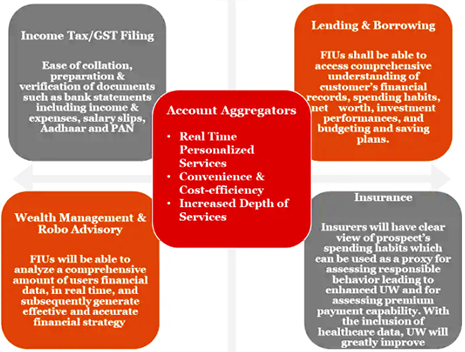
Conclusion: While the world has been harping on about data protection, India has quietly devised a means for an individual (or a business) to proactively use his or her data to obtain services, handing the data over to would-be users, say a bank or an insurance company, digitally, securely and revocably. This ecosystem will achieve maximum success if all financial services providers as well as government entities such as Income Tax and GST and other business entities are on the platform. Presently, it is not compulsory for every institution to participate.
Question: What is an Account Aggregator(AA) and its framework as per the RBI provisions? Discuss the major benefits and challenges that AA will carry with itself.
Question: Analyse the concept of account aggregator with reference to Indian economy. Discuss the advantages and limitations associated with it.
Sources:
- Account Aggregation
- Account Aggregators: new framework to access, share financial data
- Here's how account aggregators can make bank borrowings easier:
- Top Problems with Financial Data Aggregation
- Empowering Alternate Data Collection for Digital Lending with Account Aggregator Framework – Challenges & Solutions: PART – 2
- A new digital revolution in India
- Account aggregators - putting the customer in charge:
International Literacy Day
On September 8, 1967, the first International Literacy Day was celebrated. International Literacy Day (ILD) celebrations take place annually around the world to remind the public of the importance of literacy as a matter of dignity and human rights, and to advance the literacy agenda towards a more literate and sustainable society. ILD 2021 will have a special focus on the interplay of literacy and digital skills required by non-literate youth and adults.
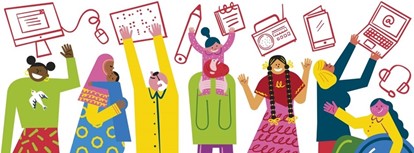
Source:
Scrub Typhus - Edukemy Current Affairs
- Context: Several cities in Uttar Pradesh have been plagued by Scrub Typhus.
- Scrub typhus is a Rickettsial infection caused by the bacteriaOrientia tsutsugamushi.
- It is a vector-borne illness that has previously been reported in India and other South Asian countries.
- Scrub typhus is spread by infected chiggers (larval mites) and the resulting bite marks are common on the groin, armpits, genitalia, and neck.
- It affects the central nervous system, cardiovascular system, renal system, respiratory system, and gastrointestinal system.
- There is no vaccine against this bacterial disease, and the antibiotic doxycycline is generally prescribed

Source:
- Two scrub typhus cases in Noida after 6 years
- Everything You Need to Know About Scrub Typhus—the ‘Mystery Fever’ That Has Plagued Uttar Pradesh
Image Source:
Reforming Financial Powers of the Armed Forces
- Context: The defence minister has released new rules to enhance the delegation of revenue procurement powers for the Army, Navy and Air Force.
- Under the new rules, critical equipment, like air-to-air refuellers for the Air Force, can be hired for short periods as compared to buying them or a long-term lease, which is both, expensive and time consuming.
- The Vice Chief of the Air Force and the commanders will have powers capped at Rs 200 crore and Rs 100 crore for such hiring.
- Delegation of Financial Powers to Defence Services (DFPDS) will empower field formations, focus on operational preparedness, promote ease of doing business and enhance jointness among the services.
- It will also enhance quicker decision making at all levels leading to better planning and optimum utilization of resources.

Source:
Image Source :
AUSINDEX 21
- Context: The Royal Australian and Indian navies will be taking part in AUSINDEX 21.
- AUSINDEX is a biennial bilateral maritime warfare exercise between India and Australia.
- First held in 2015, the exercise aims to develop maritime interoperability between two nations for a strong commitment to an open, secure, and prosperous Indo-Pacific region.
- The exercise includes complex surface, sub-surface and air operations between ships, submarines, helicopters, and long-range maritime patrol aircraft (MPA) of the two participating navies.
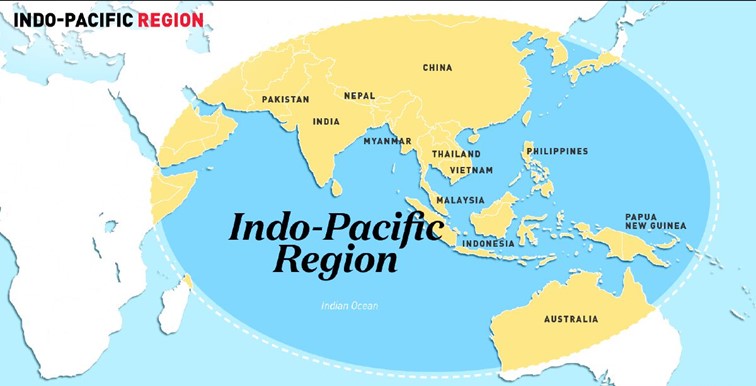
Source:
- Australia’s biennial AUSINDEX maritime warfare exercises to commence this week
- Indian Navy and RAN begin fourth edition of AUSINDEX exercise
Image Source :
Tokenisation of Card Transactions
- Context: The Reserve Bank of India has enhanced the guidelines on tokenisation of card transactions.
- Tokenisation refers to the replacement of actual card details with a unique alternate code called the 'token’ aimed at improving the safety and security of the payment system.
- Under the earlier permitted 'tokenisation' services, a unique alternate code would be generated on mobile phones and tablets of cardholders for transaction purposes.
- The RBI has now extended the device-based tokenisation to card-on-file tokenisation (CoFT) services to bar the merchants from storing actual card data.
- Card-on-file refers to card information stored by payment gateway and merchants to process future transactions.
- Card issuers have now been permitted to act as token service providers (TSP) providing service with consent and requiring additional factor of authentication (AFA) security measures.
- The scope of 'tokenisation' card payment services had also been extended to several consumer devices such as laptops, desktops, wearables like wrist watches, bands, Internet of Things (IoT), mobile phones and tablets recently.

Source:
- RBI tweaks guidelines on tokenisation of card transactions
- RBI tweaks guidelines for card tokenisation services
The employment dividend from exports
Essence: The editorial talks about India’s export journey for merchandise goods in the recent times. There is a recovery in India’s merchandise goods exports in the first 5 months of the current financial year even despite increased prices of crude oil. China has become our second largest export destination after USA for merchandise. Some employment intensive sectors (pearls and precious stones and gold jewellery) have recovered but auto industry is far from recovery. The focus of policymakers should now be on providing employment generating exports which in turn also leads to growth of these sectors.
Why you should read this article?
- To understand about the trend of Indian exports in the last 10 years.
- To understand about the recent rise in Indian exports, reasons, and the lessons one can learn from it.
- To know about the sectors whose exports can generate huge employment.
Sources:
What lies behind China’s crackdown on ed-tech companies
What lies behind China’s crackdown on ed-tech companies
Essence: The article talks about the changing dynamics in the education sector. Post pandemic, the industry has shifted from physical classes to the online platform. The online teaching has its own benefits that of customization using artificial intelligence, teaching analytics, cloud computing and learning apps. China being the most populous country in the world received over 50 per cent of the global investments in ed-tech start-ups in 2018. India too is witnessing the same but there is stark difference between how the two countries perceive such a move.
India is all set to support the movement going for privatising and commercialising the educational system here. China on the other hand seems determined that the future of its citizens still remain controlled by the government.
Why you should read this article?
- To understand the changing dynamics of the education fraternity.
- To understand the how the shift from physical classes to the online platform is perceived differently by countries.
What lies behind China’s crackdown on ed-tech companies
For Delhi, the India-US partnership remains the best bet
Essence: The withdrawal of USA from Afghanistan raised the question of the end of American leadership and dominance. However, based on the yardsticks of politics, technologies, and ideologies, it is not easy to pinpoint the end of American dominance. For Example, effective covid –19 vaccines were manufactured within USA and the US-created post-World War II order, with its emphasis on multilateralism and alliances.
Though China is rising, it is not yet the new leader considering the financial risks with Belt and Road Initiative (BRI), its dubious ethics and disregard for peer-reviewed scientific research and no new vision of global order from the existing ones.
The author views that India-US partnership is still a sound bet that addresses India’s geopolitical concerns as USA’s reach will continue in South Asia including Pakistan.
Why you should read this article?
- To understand the geopolitical implications of US withdrawal from Afghanistan.
- To understand India –US Relations with the context of South Asia.
Source:
A doctor couple creating societal change: Ekjut Foundation
Background
- High infant and maternal mortality rates among the Ho tribal community of Jharkhand
- Lack of education, medical knowledge and skills in the community
- Leads to the incoming of a couple doctor, Dr Prasanta Tripathy and Dr Nirmala Nairinto the vicinity of Narangabeda village, near Chakradhapur, Jharkhand.
Initial Hiccups
- Language barrier: Reaching out to the tribal community was a challenge due the unfamiliarity of the language.
- Diagnose system: Poor institutional medical services led to self-diagnosis of health conditions at home
- Primary survey: unavailability of health reports at grassroot level
Breakthrough
- Initiatives: opening of creches for children to address malnutrition and get medical attention, access to early childhood care and education
- Bottoms up approach: formation of groups and encouraging peer learning, building solidarity and problem-solving rather than homogeneous coverage of the disease.
- Self-analysis: The villagers started identifying problems, their causes, effects, feasible solutions to curate new medical cure
- Innovative techniques: Breaking the ice through interactive games, storytelling, picture cards and role-plays.
- Women Participation & Minimal Intervention approach
- Others: Addressing issues such as mental health, and gender-based violence, as well as debunking myths and superstition through participatory learning and action, in an evidence-based approach.
Quote:
“How wonderful it is that nobody need wait a single moment before starting to improve the world.” ― Anne Frank
Source:
Doctor Couple Innovate Steps to Reduce Infant Mortality, Model Now Replicated in 50,000 Villages:
Share the article
Get Latest Updates on Offers, Event dates, and free Mentorship sessions.

Get in touch with our Expert Academic Counsellors 👋
FAQs
UPSC Daily Current Affairs focuses on learning current events on a daily basis. An aspirant needs to study regular and updated information about current events, news, and relevant topics that are important for UPSC aspirants. It covers national and international affairs, government policies, socio-economic issues, science and technology advancements, and more.
UPSC Daily Current Affairs provides aspirants with a concise and comprehensive overview of the latest happenings and developments across various fields. It helps aspirants stay updated with current affairs and provides them with valuable insights and analysis, which are essential for answering questions in the UPSC examinations. It enhances their knowledge, analytical skills, and ability to connect current affairs with the UPSC syllabus.
UPSC Daily Current Affairs covers a wide range of topics, including politics, economics, science and technology, environment, social issues, governance, international relations, and more. It offers news summaries, in-depth analyses, editorials, opinion pieces, and relevant study materials. It also provides practice questions and quizzes to help aspirants test their understanding of current affairs.
Edukemy's UPSC Daily Current Affairs can be accessed through:
- UPSC Daily Current Affairs can be accessed through Current Affairs tab at the top of the Main Page of Edukemy.
- Edukemy Mobile app: The Daily Current Affairs can also be access through Edukemy Mobile App.
- Social media: Follow Edukemy’s official social media accounts or pages that provide UPSC Daily Current Affairs updates, including Facebook, Twitter, or Telegram channels.



